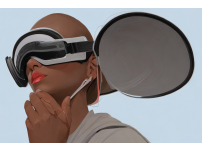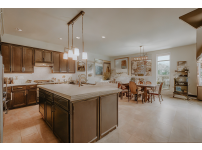식음료 업계의 가상 현실(VR): 레스토랑 디자인 및 경험 개선(Virtual Reality in the Food and Be…
본문
식음료 업계는 고객을 유치하고 식사 경험을 개선할 수 있는 새롭고 혁신적인 방법을 끊임없이 모색하고 있습니다. 이 분야의 최근 발전 중 하나는 가상 현실 기술의 통합입니다. 가상 현실은 식당 주인들이 매력적이고 유익한 방식으로 그들의 공간과 메뉴를 보여줄 수 있게 해줍니다. 본 기사에서는 가상현실이 식음료 산업에 미치는 영향과 전반적인 식사 경험 개선을 위해 어떻게 활용되고 있는지 알아보겠습니다.
식음료 업계에서 가상현실이 사용되고 있는 주요 방법 중 하나는 몰입형 메뉴 경험을 만드는 것입니다. 가상 현실을 사용하면 고객이 실제로 주문하기 전에 주문 내용을 사실적으로 확인할 수 있습니다. 이것은 고객들이 더 많은 정보에 입각한 결정을 내리는 데 도움이 될 뿐만 아니라 식사에 대한 오해나 실망을 없애줍니다. 레스토랑은 또한 가상 현실을 사용하여 공간과 분위기를 보여줌으로써 고객들에게 그들의 가게에서 식사하는 것이 어떤 것인지 미리 볼 수 있습니다.
식음료 산업에서 가상 현실이 사용되고 있는 또 다른 방법은 레스토랑 설계 및 계획입니다. 가상 현실을 통해 레스토랑 소유자는 다양한 디자인, 레이아웃 및 장식 옵션을 시뮬레이션하여 어떤 것이 가장 효과적이고 고객에게 어필할 수 있는지 판단할 수 있습니다. 또한 이 기술은 계획 및 시공 프로세스에도 도움이 되므로 레스토랑 소유자가 최종 건축 전에 쉽게 시각화하고 변경할 수 있습니다.
한국에서, 가상 현실 기술은 다양한 방식으로 식음료 업계에 의해 받아들여졌습니다. 그러한 예 중 하나는 서울에 기반을 둔 식당인 빙글 빙글이 가상현실을 사용하는 것입니다. 빙글빙글은 고객들이 가상현실을 통해 그들의 식당의 독특한 맛과 분위기를 경험할 수 있게 해줍니다. 고객들은 가상으로 식당을 둘러보고, 메뉴에서 음식을 시식할 수 있으며, 심지어 그들만의 음료를 주문 제작할 수도 있습니다. 이 기술은 빙글빙글이 다른 레스토랑과 차별화하고 새로운 고객을 유치하는 데 도움이 되었습니다.
결론적으로, 가상현실은 고객들에게 몰입감 있는 메뉴 경험을 제공하고 식당들이 공간을 보다 효과적으로 설계하고 계획할 수 있도록 도와줌으로써 식음료 산업을 빠르게 변화시키고 있습니다. 가상 현실 기술은 한국에서 받아들여졌고, 식당 주인들이 고객을 유치하고 유지하기 위한 중요한 도구가 되었습니다. 식음료 산업은 가상 현실의 영향을 받고 있는 많은 산업 중 하나에 불과하며, 이 기술이 미래에 어떻게 계속해서 산업을 발전시키고 형성할 것인지 보는 것은 흥미롭습니다.
가상 현실(VR) 기술은 식음료 산업에 혁명을 일으킬 잠재력을 가지고 있습니다. VR을 사용함으로써, 식당 주인들은 그들의 고객들을 위해 더 몰입적이고 매력적인 식사 경험을 만들 수 있습니다. 이 기술은 또한 새로운 식당을 설계하고, 새로운 메뉴 항목을 실험하고, 심지어 고객들에게 가상의 음식 맛을 제공하는 데도 사용될 수 있습니다.
한국에서는 식음료 업계에서 VR 사용이 증가하고 있습니다. 인기 있는 한국 식당인 쿡 넥스트 도어는 고객들이 가상으로 주방을 둘러보고 요리사들이 움직이는 것을 볼 수 있도록 VR 기술을 구현했습니다. 이것은 요리와 음식 준비 과정에 관심이 있는 고객들에게 큰 매력이었습니다.
또 다른 예는 "8"이라고 불리는 서울의 한 식당인데, 이것은 그들의 식사 경험에 VR 기술을 접목시켰습니다. 고객은 VR 헤드셋을 착용하고 독특하고 몰입감 있는 방식으로 음식과 음료를 상호 작용할 수 있는 가상 세계로 이동할 수 있습니다. 이것은 고객 만족도를 높일 뿐만 아니라 경쟁 시장에서 두각을 나타내는데 도움이 되었습니다.
VR 기술은 시장 분석과 메뉴 테스트에도 사용될 수 있습니다. VR을 사용하여 식당은 다양한 식사 시나리오를 시뮬레이션하고 고객의 피드백을 수집할 수 있습니다. 그런 다음 이 정보를 사용하여 메뉴 제공에 대한 정보에 입각한 결정을 내리고 전반적인 식사 환경을 개선할 수 있습니다.
결론적으로, 식음료 산업에서 VR 기술의 사용은 고객의 식사 경험을 크게 향상시킬 수 있는 잠재력을 가지고 있습니다. 가상 주방 투어에서 몰입형 식사 경험에 이르기까지, VR 기술은 식음료 산업을 한 단계 발전시킬 수 있는 능력을 가지고 있습니다. 기술이 계속 발전함에 따라 VR이 업계의 미래를 어떻게 형성하는지 보는 것은 흥미로울 것입니다.
The food and beverage industry is constantly seeking new and innovative ways to attract customers and improve the dining experience. One of the latest advancements in this area is the integration of virtual reality technology. Virtual reality allows restaurant owners to showcase their space and menu offerings in a way that is both engaging and informative. In this article, we will explore the impact of virtual reality on the food and beverage industry and how it is being used to improve the overall dining experience.
One of the main ways virtual reality is being used in the food and beverage industry is to create immersive menu experiences. With virtual reality, customers can get a realistic look at what they're ordering before they actually place their order. This not only helps customers make more informed decisions, but also eliminates any misunderstandings or disappointment with their meal. Restaurants are also using virtual reality to showcase their space and ambiance, providing customers with a preview of what it would be like to dine in their establishment.
Another way virtual reality is being used in the food and beverage industry is for restaurant design and planning. Virtual reality allows restaurant owners to simulate different designs, layouts, and decor options to determine which would be the most effective and appealing to customers. This technology also helps with the planning and construction process, making it easier for restaurant owners to visualize and make changes before the final build.
In Korea, virtual reality technology has been embraced by the food and beverage industry in various ways. One such example is the use of virtual reality by the Seoul-based restaurant, Bingle Bingle. Bingle Bingle allows customers to experience the unique flavors and atmosphere of their restaurant through virtual reality. Customers are able to virtually tour the restaurant, sample dishes from the menu, and even customize their own drinks. This technology has helped Bingle Bingle to differentiate itself from other restaurants and attract new customers.
In conclusion, virtual reality is rapidly changing the food and beverage industry by providing customers with immersive menu experiences and helping restaurants design and plan their spaces more effectively. Virtual reality technology has been embraced in Korea, and has become an important tool for restaurant owners to attract and retain customers. The food and beverage industry is just one example of the many industries that are being impacted by virtual reality, and it is exciting to see how this technology will continue to evolve and shape the industry in the future.
Virtual Reality (VR) technology has the potential to revolutionize the food and beverage industry. By using VR, restaurant owners can create a more immersive and engaging dining experience for their customers. This technology can also be used for designing new restaurants, experimenting with new menu items and even offering virtual food tastings to customers.
In Korea, the use of VR in the food and beverage industry is on the rise. A popular Korean restaurant, Cook Next Door, has implemented VR technology to allow customers to virtually tour the kitchen and see the chefs in action. This has been a major draw for customers who are interested in the process of cooking and food preparation.
Another example is a restaurant in Seoul, called “8”, which has incorporated VR technology into their dining experience. Customers can put on VR headsets and be transported to a virtual world where they can interact with their food and drink in a unique and immersive way. This has not only increased customer satisfaction, but has also helped the restaurant to stand out in a competitive market.
VR technology can also be used for market analysis and menu testing. By using VR, restaurants can simulate different dining scenarios and gather customer feedback. This information can then be used to make informed decisions about menu offerings and improve the overall dining experience.
In conclusion, the use of VR technology in the food and beverage industry has the potential to greatly improve the dining experience for customers. From virtual tours of the kitchen to immersive dining experiences, VR technology has the ability to take the food and beverage industry to the next level. As technology continues to advance, it will be exciting to see how VR continues to shape the future of the industry.














댓글목록 0